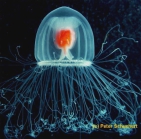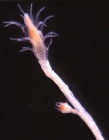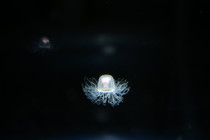WoRMS taxon details
Turritopsis rubra (Farquhar, 1895)
284469 (urn:lsid:marinespecies.org:taxname:284469)
accepted
Species
Corydendrium zelandicum Stechow, 1924 · unaccepted (synonym)
Tubiclava rubra Farquhar, 1895 · unaccepted (genus transfer)
marine, terrestrial
(of Tubiclava rubra Farquhar, 1895) Farquhar, H. 1895. Description of two new gymnoblastic Hydroids. Transactions and Proceedings of the New Zealand Institute 27: 208-209, plate 13., available online at https://www.biodiversitylibrary.org/page/3300792
page(s): 209 [details]
page(s): 209 [details]
Type locality contained in Wellington Harbour
type locality contained in Wellington Harbour [from synonym] [view taxon] [details]
Taxonomy This species has until 2004 been synonymized with T. nutricula McCrady, 1857, a medusa from the western Atlantic....
description
Polyp stage:
Hydroids forming initially stolonial, later erect colonies, arising from attached, ramified stolons....
Taxonomy This species has until 2004 been synonymized with T. nutricula McCrady, 1857, a medusa from the western Atlantic. Morphological and molecular data, however, showed it to be distinct. [details]
description
Polyp stage:
Hydroids forming initially stolonial, later erect colonies, arising from attached, ramified stolons....
description
Polyp stage:
Hydroids forming initially stolonial, later erect colonies, arising from attached, ramified stolons. Branching of stems irregular, reaching 15 mm (up to 50 mm in very large colonies). Branches originate at acute angles and are adnate for some distance afterwards, then curving away and becoming free. Branches 160 to 200 mm in diameter, some few expanding distally; perisarc firm, mostly heavily infested with detritus and algae, without annulations, terminating below hydranths. Perisarc double-layered, inner layer corrugated. Hydranths in material from New Zealand intensively orange-red. Relaxed hydranths are spindle shaped and reach 0.8 mm in height, with 12 to 20 filiform tentacles of different length (max. 0.6 mm), highly contractile, scattered over distal 3/4 of hydranth; hypostome conical, hydranth not retractable into perisarc, stressed hydranths contract to egg shape. Medusae buds arise below hydranths in perisarc covered region, mostly one bud, occasionally more. The medusae buds arise from short stems which may also be adnate for some distance after their origin. Also hydranths arising directly from stolons but belonging to an branching colony can bear medusae buds. Nematocysts:
a) microbasic euryteles, (7-8)x(3-4)um, s=0.9.
b) microbasic mastigophores, rare, in body and cauli of larger polyps, (5.5-7)x(3-4)um, s=0.7.
c) desmonemes, discharged with four coils, (4.5-5.5)x(2.5-3)um.
Young medusa:
Newly released medusa spherical, light orange in New Zealand material, manubrium with four perradial lips with nematocyst clusters, manubrial peduncule present, base of manubrium and transition to radial canals with very large vacuolated gastrodermal cells, four interradial orange pads on distal part of manubrium. With four radial canals and circular canal. With eight tentacles, arising from bulbs with an inconspicuous adaxial ocellus. The exumbrella appears granulated and is slightly opaque. Nematocysts:
a) microbasic euryteles in tentacles, (7-8)x(3-4)um.
b) microbasic euryteles of manubrium, (8.5-10)x(3-3.5)um.
c) desmonemes, discharged with four coils, (5-6.5)x (2.5-3.5)um.
Adult medusa:
Adult medusa up to 7 mm high, bell-shaped, higher than wide, jelly thin, at apex thicker. Stomach cross-shaped in axial view, manubrium not longer than bell cavity. Manubrium with intensively red colour. Four radial masses of large vacuolated gastrodermal cells form a compact mass above stomach. Mouth with four lips with nematocyst clusters along margin. Four radial canals which continue through vacuolated gastrodermal masses to manubrium. Gonads on interradial walls of manubrium, in mature females with developing embryos and planulae. Many tentacles (up to 120), arising from closely spaced tentacle bulbs, these with adaxial ocelli. Nematocysts:
a) microbasic euryteles in tentacles, (8-9)x(4-5)um, s=0.9.
b) microbasic euryteles from manubrium, (7-9.5)x(3-4)um, s=0.7.
c) desmonemes of tentacles, (5.5-7)x(3.5-4.5)um. [details]
Polyp stage:
Hydroids forming initially stolonial, later erect colonies, arising from attached, ramified stolons. Branching of stems irregular, reaching 15 mm (up to 50 mm in very large colonies). Branches originate at acute angles and are adnate for some distance afterwards, then curving away and becoming free. Branches 160 to 200 mm in diameter, some few expanding distally; perisarc firm, mostly heavily infested with detritus and algae, without annulations, terminating below hydranths. Perisarc double-layered, inner layer corrugated. Hydranths in material from New Zealand intensively orange-red. Relaxed hydranths are spindle shaped and reach 0.8 mm in height, with 12 to 20 filiform tentacles of different length (max. 0.6 mm), highly contractile, scattered over distal 3/4 of hydranth; hypostome conical, hydranth not retractable into perisarc, stressed hydranths contract to egg shape. Medusae buds arise below hydranths in perisarc covered region, mostly one bud, occasionally more. The medusae buds arise from short stems which may also be adnate for some distance after their origin. Also hydranths arising directly from stolons but belonging to an branching colony can bear medusae buds. Nematocysts:
a) microbasic euryteles, (7-8)x(3-4)um, s=0.9.
b) microbasic mastigophores, rare, in body and cauli of larger polyps, (5.5-7)x(3-4)um, s=0.7.
c) desmonemes, discharged with four coils, (4.5-5.5)x(2.5-3)um.
Young medusa:
Newly released medusa spherical, light orange in New Zealand material, manubrium with four perradial lips with nematocyst clusters, manubrial peduncule present, base of manubrium and transition to radial canals with very large vacuolated gastrodermal cells, four interradial orange pads on distal part of manubrium. With four radial canals and circular canal. With eight tentacles, arising from bulbs with an inconspicuous adaxial ocellus. The exumbrella appears granulated and is slightly opaque. Nematocysts:
a) microbasic euryteles in tentacles, (7-8)x(3-4)um.
b) microbasic euryteles of manubrium, (8.5-10)x(3-3.5)um.
c) desmonemes, discharged with four coils, (5-6.5)x (2.5-3.5)um.
Adult medusa:
Adult medusa up to 7 mm high, bell-shaped, higher than wide, jelly thin, at apex thicker. Stomach cross-shaped in axial view, manubrium not longer than bell cavity. Manubrium with intensively red colour. Four radial masses of large vacuolated gastrodermal cells form a compact mass above stomach. Mouth with four lips with nematocyst clusters along margin. Four radial canals which continue through vacuolated gastrodermal masses to manubrium. Gonads on interradial walls of manubrium, in mature females with developing embryos and planulae. Many tentacles (up to 120), arising from closely spaced tentacle bulbs, these with adaxial ocelli. Nematocysts:
a) microbasic euryteles in tentacles, (8-9)x(4-5)um, s=0.9.
b) microbasic euryteles from manubrium, (7-9.5)x(3-4)um, s=0.7.
c) desmonemes of tentacles, (5.5-7)x(3.5-4.5)um. [details]
Schuchert, P. (2024). World Hydrozoa Database. Turritopsis rubra (Farquhar, 1895). Accessed through: World Register of Marine Species at: https://www.marinespecies.org/aphia.php?p=taxdetails&id=284469 on 2024-09-18
Date
action
by
![]() The webpage text is licensed under a Creative Commons Attribution 4.0 License
The webpage text is licensed under a Creative Commons Attribution 4.0 License
original description
(of Corydendrium zelandicum Stechow, 1924) Stechow, E. 1924a. Diagnosen neuer Hydroiden aus Australien. - Zoologischer Anzeiger 59: 57-69.
page(s): 57 [details] Available for editors [request]
[request]
original description (of Tubiclava rubra Farquhar, 1895) Farquhar, H. 1895. Description of two new gymnoblastic Hydroids. Transactions and Proceedings of the New Zealand Institute 27: 208-209, plate 13., available online at https://www.biodiversitylibrary.org/page/3300792
page(s): 209 [details]
context source (Hexacorallia) Fautin, Daphne G. (2013). Hexacorallians of the World. (look up in IMIS) [details]
basis of record Vervoort, W.; Schuchert, P. & van der Land, J. (2000-2007). as a contribution to UNESCO-IOC Register of Marine Organisms. (look up in IMIS) [details]
additional source Miglietta, M. P., Piraino, S., Kubota, S., Schuchert, P. (2007). Species in the genus Turritopsis (Cnidaria, Hydrozoa): a molecular evaluation. <em>Journal of Zoological Systematics and Evolutionary Research.</em> 45(1): 11-19., available online at https://doi.org/10.1111/j.1439-0469.2006.00379.x [details] Available for editors [request]
[request]
additional source Cairns, S.D., L. Gershwin, F.J. Brook, P. Pugh, E.W. Dawson, O.V.; Ocaña, W. Vervoort, G. Williams, J.E. Watson, D.M. Opresko, P. Schuchert, P.M. Hine, D.P. Gordon, H.I. Campbell, A.J. Wright, J.A.Sánchez & D.G. Fautin. (2009). Phylum Cnidaria: corals, medusae, hydroids, myxozoans. <em>in: Gordon, D.P. (Ed.) (2009). New Zealand inventory of biodiversity: 1. Kingdom Animalia: Radiata, Lophotrochozoa, Deuterostomia.</em> pp. 59-101., available online at https://repository.si.edu/handle/10088/8431 [details] Available for editors [request]
[request]
redescription Schuchert P. (1996). The marine fauna of New Zealand: Athecate hydroids and their medusae (Cnidaria: Hydrozoa). <em>New Zealand Oceanographic Institute Memoir.</em> 106 : 1-159.
page(s): 16, fig. 5a-e; note: [as Turritopsis nutricula ] [details]
redescription Schuchert, P. (2004). Revision of the European athecate hydroids and their medusae (Hydrozoa, Cnidaria): families Oceanidae and Pachycordylidae. <em>Revue Suisse de Zoologie.</em> 111 2: 315-369., available online at https://biodiversitylibrary.org/page/41187667 [details]
page(s): 57 [details] Available for editors
original description (of Tubiclava rubra Farquhar, 1895) Farquhar, H. 1895. Description of two new gymnoblastic Hydroids. Transactions and Proceedings of the New Zealand Institute 27: 208-209, plate 13., available online at https://www.biodiversitylibrary.org/page/3300792
page(s): 209 [details]
context source (Hexacorallia) Fautin, Daphne G. (2013). Hexacorallians of the World. (look up in IMIS) [details]
basis of record Vervoort, W.; Schuchert, P. & van der Land, J. (2000-2007). as a contribution to UNESCO-IOC Register of Marine Organisms. (look up in IMIS) [details]
additional source Miglietta, M. P., Piraino, S., Kubota, S., Schuchert, P. (2007). Species in the genus Turritopsis (Cnidaria, Hydrozoa): a molecular evaluation. <em>Journal of Zoological Systematics and Evolutionary Research.</em> 45(1): 11-19., available online at https://doi.org/10.1111/j.1439-0469.2006.00379.x [details] Available for editors
additional source Cairns, S.D., L. Gershwin, F.J. Brook, P. Pugh, E.W. Dawson, O.V.; Ocaña, W. Vervoort, G. Williams, J.E. Watson, D.M. Opresko, P. Schuchert, P.M. Hine, D.P. Gordon, H.I. Campbell, A.J. Wright, J.A.Sánchez & D.G. Fautin. (2009). Phylum Cnidaria: corals, medusae, hydroids, myxozoans. <em>in: Gordon, D.P. (Ed.) (2009). New Zealand inventory of biodiversity: 1. Kingdom Animalia: Radiata, Lophotrochozoa, Deuterostomia.</em> pp. 59-101., available online at https://repository.si.edu/handle/10088/8431 [details] Available for editors
redescription Schuchert P. (1996). The marine fauna of New Zealand: Athecate hydroids and their medusae (Cnidaria: Hydrozoa). <em>New Zealand Oceanographic Institute Memoir.</em> 106 : 1-159.
page(s): 16, fig. 5a-e; note: [as Turritopsis nutricula ] [details]
redescription Schuchert, P. (2004). Revision of the European athecate hydroids and their medusae (Hydrozoa, Cnidaria): families Oceanidae and Pachycordylidae. <em>Revue Suisse de Zoologie.</em> 111 2: 315-369., available online at https://biodiversitylibrary.org/page/41187667 [details]
 Present
Present  Present in aphia/obis/gbif/idigbio
Present in aphia/obis/gbif/idigbio  Inaccurate
Inaccurate  Introduced: alien
Introduced: alien  Containing type locality
Containing type locality
Nontype MHNG INVE-33469 [details]
Nontype MHNG MHNG- INVE-33463, geounit Wellington [details]
Nontype MHNG MHNG-INVE-33455, geounit Auckland [details]
Nontype MHNG MHNG-INVE-34180, geounit Tasmania [details]
From editor or global species database
Biology polyp colonial, medusa benthic, shallow water to intertidal [details]Taxonomy This species has until 2004 been synonymized with T. nutricula McCrady, 1857, a medusa from the western Atlantic. Morphological and molecular data, however, showed it to be distinct. [details]
description
Polyp stage:
Hydroids forming initially stolonial, later erect colonies, arising from attached, ramified stolons. Branching of stems irregular, reaching 15 mm (up to 50 mm in very large colonies). Branches originate at acute angles and are adnate for some distance afterwards, then curving away and becoming free. Branches 160 to 200 mm in diameter, some few expanding distally; perisarc firm, mostly heavily infested with detritus and algae, without annulations, terminating below hydranths. Perisarc double-layered, inner layer corrugated. Hydranths in material from New Zealand intensively orange-red. Relaxed hydranths are spindle shaped and reach 0.8 mm in height, with 12 to 20 filiform tentacles of different length (max. 0.6 mm), highly contractile, scattered over distal 3/4 of hydranth; hypostome conical, hydranth not retractable into perisarc, stressed hydranths contract to egg shape. Medusae buds arise below hydranths in perisarc covered region, mostly one bud, occasionally more. The medusae buds arise from short stems which may also be adnate for some distance after their origin. Also hydranths arising directly from stolons but belonging to an branching colony can bear medusae buds. Nematocysts:
a) microbasic euryteles, (7-8)x(3-4)um, s=0.9.
b) microbasic mastigophores, rare, in body and cauli of larger polyps, (5.5-7)x(3-4)um, s=0.7.
c) desmonemes, discharged with four coils, (4.5-5.5)x(2.5-3)um.
Young medusa:
Newly released medusa spherical, light orange in New Zealand material, manubrium with four perradial lips with nematocyst clusters, manubrial peduncule present, base of manubrium and transition to radial canals with very large vacuolated gastrodermal cells, four interradial orange pads on distal part of manubrium. With four radial canals and circular canal. With eight tentacles, arising from bulbs with an inconspicuous adaxial ocellus. The exumbrella appears granulated and is slightly opaque. Nematocysts:
a) microbasic euryteles in tentacles, (7-8)x(3-4)um.
b) microbasic euryteles of manubrium, (8.5-10)x(3-3.5)um.
c) desmonemes, discharged with four coils, (5-6.5)x (2.5-3.5)um.
Adult medusa:
Adult medusa up to 7 mm high, bell-shaped, higher than wide, jelly thin, at apex thicker. Stomach cross-shaped in axial view, manubrium not longer than bell cavity. Manubrium with intensively red colour. Four radial masses of large vacuolated gastrodermal cells form a compact mass above stomach. Mouth with four lips with nematocyst clusters along margin. Four radial canals which continue through vacuolated gastrodermal masses to manubrium. Gonads on interradial walls of manubrium, in mature females with developing embryos and planulae. Many tentacles (up to 120), arising from closely spaced tentacle bulbs, these with adaxial ocelli. Nematocysts:
a) microbasic euryteles in tentacles, (8-9)x(4-5)um, s=0.9.
b) microbasic euryteles from manubrium, (7-9.5)x(3-4)um, s=0.7.
c) desmonemes of tentacles, (5.5-7)x(3.5-4.5)um. [details]
| Language | Name | |
|---|---|---|
| English | Crimson jelly | [details] |
To Barcode of Life (3 barcodes)
To Biodiversity Heritage Library (2 publications)
To Biodiversity Heritage Library (5 publications) (from synonym Tubiclava rubra Farquhar, 1895)
To European Nucleotide Archive, ENA (Turritopsis rubra)
To GenBank (9868 nucleotides; 3 proteins)
To GenBank (9868 nucleotides; 3 proteins) (from synonym Tubiclava rubra Farquhar, 1895)
To ITIS
To Biodiversity Heritage Library (2 publications)
To Biodiversity Heritage Library (5 publications) (from synonym Tubiclava rubra Farquhar, 1895)
To European Nucleotide Archive, ENA (Turritopsis rubra)
To GenBank (9868 nucleotides; 3 proteins)
To GenBank (9868 nucleotides; 3 proteins) (from synonym Tubiclava rubra Farquhar, 1895)
To ITIS




